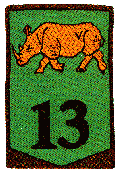13
This number is a prime.
Just showing those entries submitted by 'Beedassy': (Click here to show all)
 |
| Photo credit: Patrick Kik |
 13 is the hypotenuse of the unique Pythagorean triangle
whose area numerically equals its perimeter. [Beedassy]
13 is the hypotenuse of the unique Pythagorean triangle
whose area numerically equals its perimeter. [Beedassy]
 The only prime subscript of a triangular number that is
also a square pyramidal number : 1 + 2 + 3 + ... + 11 + 12
+ 13 = 12 + 22 + 32 +
42 + 52 + 62. [Beedassy]
The only prime subscript of a triangular number that is
also a square pyramidal number : 1 + 2 + 3 + ... + 11 + 12
+ 13 = 12 + 22 + 32 +
42 + 52 + 62. [Beedassy]
 The prime whose square is equal to the sum of squares of
all digits in which primes end: 132 =
12 + 22 + 32 +
52 + 72 + 92. [Beedassy]
The prime whose square is equal to the sum of squares of
all digits in which primes end: 132 =
12 + 22 + 32 +
52 + 72 + 92. [Beedassy]
 The largest prime p such that p modulo
q is square-free for any prime q below
p. [Beedassy]
The largest prime p such that p modulo
q is square-free for any prime q below
p. [Beedassy]
 The smallest prime that when concatenated to its Collatz
sequence (13 --> 40 --> 20 -->
10 --> 5 --> 16 --> 8 --> 4-2-1)
inexorable ending 4-2-1
forms another prime: 13421. Note that a reverse
concatenation also yields a prime (12413). [Beedassy]
The smallest prime that when concatenated to its Collatz
sequence (13 --> 40 --> 20 -->
10 --> 5 --> 16 --> 8 --> 4-2-1)
inexorable ending 4-2-1
forms another prime: 13421. Note that a reverse
concatenation also yields a prime (12413). [Beedassy]
 The smallest prime that is equidistant by a prime (3)
between the sum of squares of its digits (12 +
32) and the square of the sum of its digits (1 +
3)2. [Beedassy]
The smallest prime that is equidistant by a prime (3)
between the sum of squares of its digits (12 +
32) and the square of the sum of its digits (1 +
3)2. [Beedassy]
 In the great ancient Indian epic Mahabharata, the
righteous Pandava clan, after losing their staked kingdom
through deceit in a game of dice schemed out by the envious
Kaurauva cousins, were forced to undergo 13 years of exile. [Beedassy]
In the great ancient Indian epic Mahabharata, the
righteous Pandava clan, after losing their staked kingdom
through deceit in a game of dice schemed out by the envious
Kaurauva cousins, were forced to undergo 13 years of exile. [Beedassy]
 Religious scholar A. C. Bhaktivedanta Swami Prabhupada gives the equivalent length of a yojana as approximately 13 kilometers. [Beedassy]
Religious scholar A. C. Bhaktivedanta Swami Prabhupada gives the equivalent length of a yojana as approximately 13 kilometers. [Beedassy]
 In chess, a Bishop controls a maximum of 13 squares of a given color. [Beedassy]
In chess, a Bishop controls a maximum of 13 squares of a given color. [Beedassy]
 After needing 13 liters of blood for a major surgery during
his teens, Australian James Christopher Harrison pledged to
return the favour eventually becoming world record blood
donor after the discovery in his blood of a unique antibody
that cures Rhesus disease thereby saving millions of babies
over 6 decades. [Beedassy]
After needing 13 liters of blood for a major surgery during
his teens, Australian James Christopher Harrison pledged to
return the favour eventually becoming world record blood
donor after the discovery in his blood of a unique antibody
that cures Rhesus disease thereby saving millions of babies
over 6 decades. [Beedassy]
 The 13 end-digits of the overwhelmingly gigantic Graham's
number (g64) form a second prime
concatenation: 7262464195387. [Beedassy]
The 13 end-digits of the overwhelmingly gigantic Graham's
number (g64) form a second prime
concatenation: 7262464195387. [Beedassy]